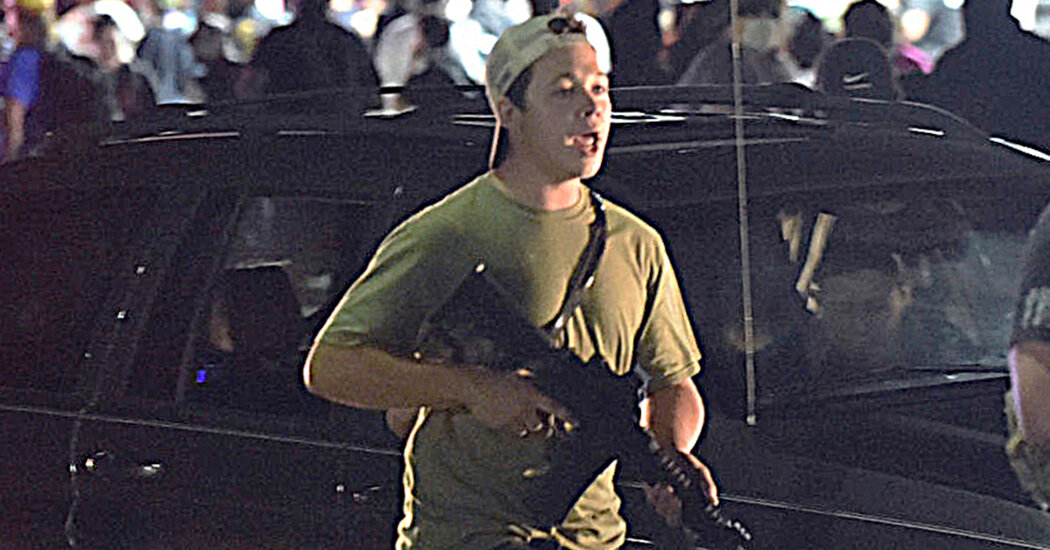Mr. Rittenhouse was acquitted of all charges in the fatal shootings of two men and wounding of another during a protest in 2020 that was precipitated by the shooting of a Black man by a police officer.
The semiautomatic rifle used by Kyle Rittenhouse, the teenager acquitted of criminal charges in the fatal shooting of two men and the wounding of another during a street protest in Kenosha, Wis., in 2020, will be destroyed under an agreement approved by a judge on Friday.
Mr. Rittenhouse, 19, had consented to the agreement’s terms before a hearing in Kenosha County Circuit Court, according to his lawyer, but did not attend the hourlong proceeding.
A spokesman for Mr. Rittenhouse had previously said that he did not want the AR-15-style rifle to become a political symbol or trophy.
The rifle, a Smith & Wesson M&P 15, will be turned over to the Kenosha Police Department and taken to a state crime lab to be destroyed, along with the rifle’s magazine and scope, a prosecutor said on Friday.
The prosecutor, Assistant District Attorney Thomas Binger of Kenosha County, said that the process would most likely be completed in late April.
“It will not be in anyone’s possession,” Mr. Binger said.
Mark Richards, Mr. Rittenhouse’s lawyer, filed a motion earlier this month seeking for the rifle, its ammunition and a mask worn by his client on the night of the shootings to be returned to Mr. Rittenhouse.
“I’ve discussed this with my client, and it meets his goals,” Mr. Richards said of the agreement, noting that Mr. Rittenhouse’s other possessions had been returned to him.
Guns and Gun Control in the U.S.
- The Children’s Gun Crisis: More kids are becoming both victims and shooters, as pandemic trauma and a surge in gun purchases collide.
- Understand ‘Ghost Guns’: Untraceable firearms that can be ordered online are fueling an epidemic of violence.
- Inside 2021’s Homicide Surge: These four stories offer a glimpse of the scope and toll of gun violence in America.
- A Landmark Case: The Supreme Court is poised to issue its first major Second Amendment ruling in more than a decade — and the implications could be enormous.
- America’s Arms Race: While gun sales have been climbing for decades, Americans have been on a buying spree fueled by the pandemic.
Mr. Rittenhouse was found not guilty of homicide and other charges in November after a two-week trial, a case that became a flash point in a national debate over vigilantism, gun rights and self-defense.
His actions drew approval from many prominent conservatives, including former President Donald J. Trump, who met with Mr. Rittenhouse in Florida after his acquittal.
At the same time, the images of Mr. Rittenhouse wielding a semiautomatic weapon on city streets during racial justice protests elicited widespread condemnation.
Then 17 years old, Mr. Rittenhouse traveled from his home in rural Illinois to Kenosha as the city descended into civil unrest in August 2020 over the shooting of Jacob Blake by a police officer who had been responding to what the authorities said was a domestic complaint. Mr. Blake, who is Black, was shot several times in the back by the officer, leaving him partly paralyzed and touching off protests.
Mr. Rittenhouse was among a group of heavily armed civilians who took to the city’s streets to guard businesses and properties as demonstrators smashed street lamps and set cars and shops on fire.
During a skirmish, Mr. Rittenhouse was chased into a parking lot by Joseph Rosenbaum, 36, who was unarmed and behaving erratically, a video of the confrontation showed. In the video, which was played during his trial, Mr. Rittenhouse turned toward and fatally shot Mr. Rosenbaum, who had been living in Kenosha.
Mr. Rittenhouse then opened fire on two other people, Anthony Huber and Gaige Grosskreutz, who pursued him as he fled, according to testimony. Mr. Huber was killed and Mr. Grosskreutz survived.
Facing felony charges, the man who bought Mr. Rittenhouse the military-style rifle because he was too young to purchase it himself agreed this month to plead no contest to lesser charges in a deal.
The man, Dominick Black, 20, was a witness for the prosecution in the homicide case against Mr. Rittenhouse. He also consented to the rifle’s destruction, prosecutors said on Friday.
While there was unanimity over what should happen to Mr. Rittenhouse’s rifle, the fate of $2 million raised by his supporters and lawyers for his bail became a sticking point leading up to the hearing on Friday.
A hedge fund had sought to stake its claim to the $2 million, plus interest, contending in court documents that it had given a former lawyer for Mr. Rittenhouse $300,000 toward Mr. Rittenhouse’s bail and was entitled to the entire amount.
The fund, the Patent and Trademark Hedge Fund Trust, had suggested that contributing to Mr. Rittenhouse’s defense would be a good investment, said Judge Bruce E. Schroeder of the Circuit Court.
“That’s quite a leap of faith in any criminal prosecution,” Judge Schroeder said.
Judge Schroeder said he understood that hedge funds were prone to taking risks. But this, he said, was pushing it. He rejected the fund’s overture and said that the money would go to Mr. Richards’s law firm and a legal-defense fund known as the #FightBack Foundation.
“Who’s going to pay the interest?” Judge Schroeder said of the hedge fund’s motion. “We weren’t. This is bizarre.”


























